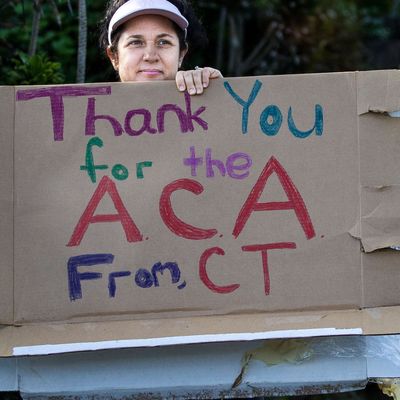
The Affordable Care Act was always big. It was always complicated. It was always inelegant. But it was always meant to be universal, reaching all Americans regardless of their income or political tendencies or hometown. Yet over the past two years, the law has splintered and that goal has been dashed, at least for now. And the greatest risk posed to the A.C.A. by the court decision in Halbig v. Burwell, released this week, is that the law might splinter further.
“Might” is a really important word there. The Halbig decision raises many more questions than it answers, the biggest being whether the courts might end up taking away the insurance subsidies that make coverage affordable for millions of American families. If that happened, in some states, the Medicaid expansion and the subsidies in the law would be available; coverage would be nearly universal. In others, the Medicaid expansion would remain available, but the subsidies might lapse, making insurance unaffordable for many middle-class families. In yet other states, there is the potential that neither the Medicaid expansion nor the subsidies for private insurance would be available.
To step back and look at the nitty-gritty of the law that helps explain all of this: The Medicaid program covers about half of the newly insured under the A.C.A. The other half must buy private coverage, mostly on insurance “exchanges,” with the federal government subsidizing much of the cost for lower-income and middle-class households. Some states set up their own exchanges. But three dozen chose to use the federal government’s architecture. In Halbig, a D.C. court determined that subsidies are admissible only for families who purchased coverage via state-run exchanges — not the federal exchange.
The Halbig decision is not at all final or definitive. Families will continue to receive subsidies while Halbig and similar cases wind their way through the legal system. (A different courtupheld the subsides on the federal exchanges just this week. There’s some chance the Supreme Court will end up ruling on the issue.) Right now, many legal scholars consider it unlikely that the courts will end up rescinding the subsidies — thus enraging a lot of Americans, significantly disrupting insurance and health-care businesses and tearing apart the fabric of the law — but the potential is there.
That scenario would hugely amplify the state-by-state differences in how the law functions — differences that fall on a roughly red-to-blue axis, with a number of outliers. (The law is working great in bright-red Kentucky, for instance, and functioning a lot worse in deep-blue Maryland.) In part, those existing differences stem from states’ varying enthusiasm about the law and their competency in implementing it. In part, they stem from the surprise 2012 Supreme Court decision that allowed states to opt out of the Medicaid expansion.
The differences in how the law is working in different states are already stark. Last year, I visited a homeless shelter in Chicago — a blue city in a blue state — to see the coverage expansion in action. Social workers were signing shelter residents up for Medicaid late into the evening, and had mounted a campaign to reach the city’s vulnerable uninsured wherever they might be, including under bridges and on park benches. Many of the shelter’s residents had never heard of the law, and were wary about signing on to a government program. But social workers explained the benefits, and helped residents pull together the information they needed to get enrolled.
Then, this year, I visited a homeless shelter in Arkansas, a red state that nevertheless accepted the Medicaid expansion in the Affordable Care Act. (Thus far, about half of states have declined to do the same, including states with a large number of uninsured people, like Texas, Mississippi, and South Carolina.) I ended up informing several of the residents that they probably qualified for the Medicaid expansion. (The observer effect!) Many had only a rough idea of what the law did, and no social worker had ever arrived, clipboard and laptop in hand, to sign them up.
If the courts end up confirming the Halbig decision, the subsidies portion of the law would fracture, much like the Medicaid portion of the law fractured due to that surprise 2012 Supreme Court decision. Coverage might become nearly universal in California. But millions of Texans — ranging from the very poor to the middle class — might continue to find insurance wholly unaffordable.
That’s a particularly dangerous situation in this hyperpolarized political climate. Blue states seeing the advantages of the law would lobby for it; red states seeing none of its upsides but still realizing its downside — the taxes that pay for the expansion are federal, after all — might further harden against it. In a great ironic twist, a law designed to redistribute money from wealthier blue states to poorer red states might end up redistributing money from poorer red states to wealthier blue ones.
That might give a Republican president and other Republican candidates yet more incentive to campaign on the law’s dismantling to shore up his or her base. Liberals have long hoped that the law’s universality would protect it; it is often politically impossible to take a federal program away from families — especially middle-class families — once they have it and like it. A smaller Affordable Care Act is a far more vulnerable Affordable Care Act, and that’s the great danger posed by Halbig.





























